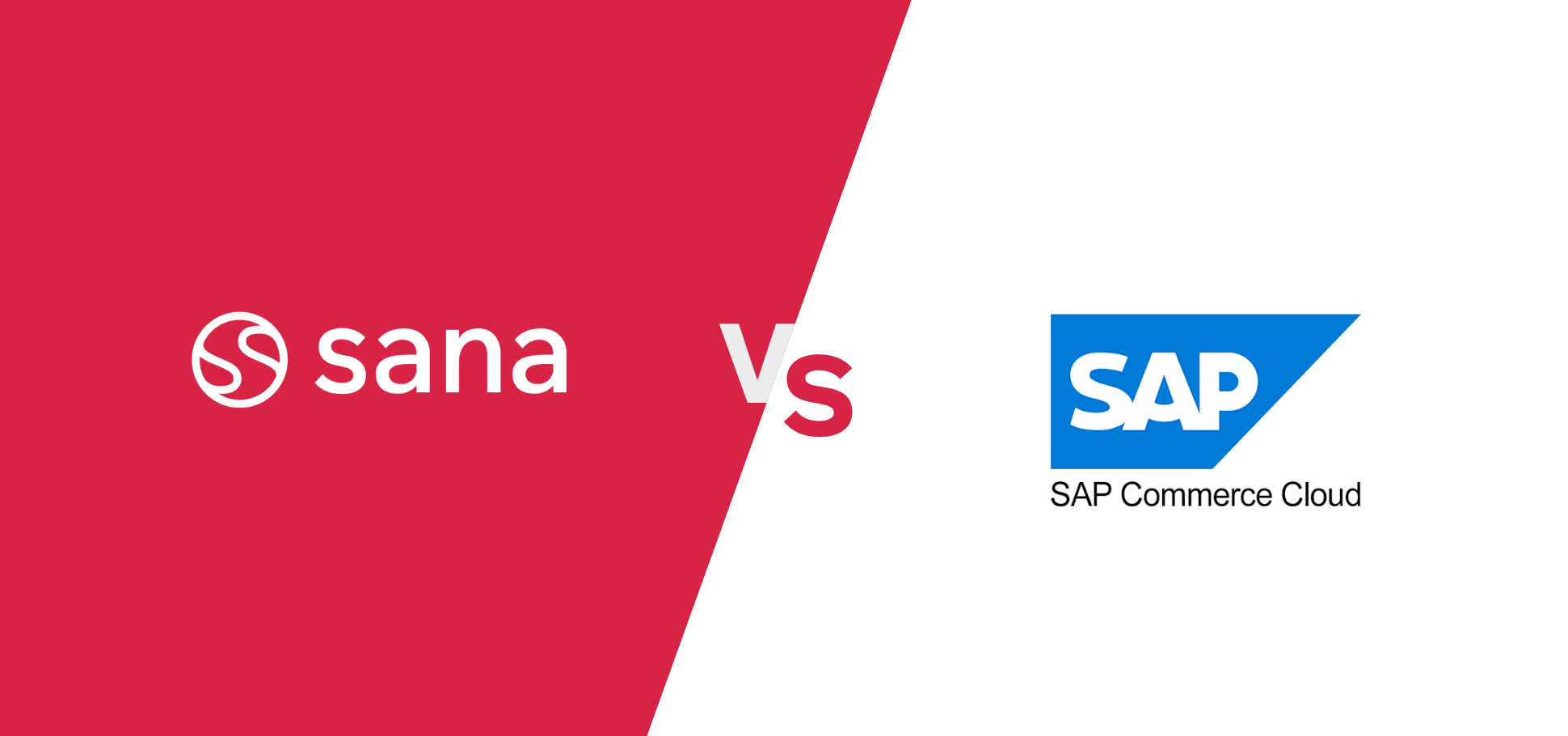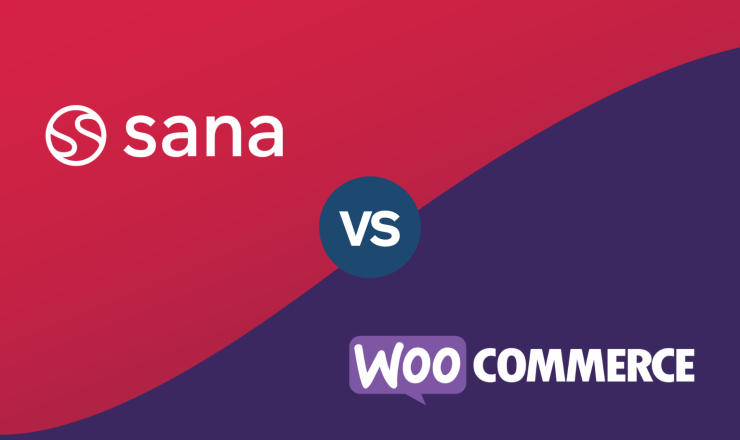

When it comes to selecting an enterprise e-commerce platform, the decision is crucial for long-term success. Two prominent options in the market are SAP Commerce Cloud and Sana Commerce Cloud, each offering unique strengths and capabilities.
SAP Commerce Cloud, a well-established player in the market, boasts a robust feature set and a wide range of capabilities. Its inclusion in the SAP S/4HANA suite provides a unified ecosystem for businesses seeking an integrated solution. Recent advancements like the Composable Edition, flexible pricing models, and AI-driven features like Joule further enhance its appeal.
On the other hand, Sana Commerce Cloud offers a more focused, best-of-breed e-commerce solution, excelling in areas like seamless ERP integration, agility, and a rapid time-to-market.
Let’s delve deeper into the key differences between these two platforms to help you make an informed decision that aligns with your specific business needs and goals.
1. Best-of-breed vs. Best-of-suite: Focus matters
Sana Commerce Cloud is laser-focused on one thing: delivering a best-of-breed e-commerce solution. We’re not trying to be everything to everyone. Our platform is designed specifically to help you accelerate growth and strengthen customer relationships through a reliable, scalable online store.
On the other hand, SAP Commerce Cloud is part of a larger product suite (SAP S/4HANA). While this can offer some benefits in terms of a unified ecosystem, it also means you’re potentially locked into a one-size-fits-all solution that may not perfectly align with your unique needs.
With Sana Commerce Cloud, you get a highly configurable platform that’s tailored to your specific B2B requirements. Plus, our seamless SAP ERP integration ensures real-time data accuracy and eliminates the need for complex middleware.
2. Time to market: Get up and running quickly
In the fast-paced world of e-commerce, speed matters. Sana Commerce Cloud is built for agility. Our out-of-the-box solution can be implemented in as little as 90 days, allowing you to start driving revenue and seeing ROI faster.
In contrast, SAP Commerce Cloud is known for its rigid platform structure, which can lead to prolonged development cycles and significant expenses when launching new storefronts or making simple updates. Companies often report that launching additional storefronts can take several months, significantly delaying time to market.
Sana Commerce Cloud simplifies the complexities of e-commerce functionalities with an easy-to-use user interface that eliminates the need for extensive coding on product lists and content element pages. This flexibility allows businesses to make quick changes while reducing the time and cost involved in maintaining and expanding your online presence.
3. Total cost of ownership: The real cost of e-commerce
Choosing an e-commerce platform isn’t just about the upfront cost. It’s about the total cost of ownership over the lifetime of the solution.
Sana Commerce Cloud offers a transparent, subscription-based pricing model that includes licensing, hosting, and support. Our seamless ERP integration also eliminates the need for costly middleware or custom development. Additionally, our lower license fees and reduced development costs make it more affordable for organizations to scale and launch additional storefronts.
On the other hand, SAP Commerce Cloud’s pricing structure can be less transparent, with additional costs for implementation, customization, and ongoing maintenance. The high license fees and continuous development costs associated with SAPCC can be prohibitive, especially when trying to scale or launch additional storefronts. The lack of an out-of-the-box ERP integration can also lead to unexpected expenses down the road.
The importance of e-commerce flexibility
When choosing an e-commerce platform, consider its impact on your resources and long-term flexibility.
SAP Commerce Cloud, while powerful, often demands a significant investment in terms of both time and money.
The challenges:
- High maintenance costs: SAPCC often requires a large, dedicated team to maintain and optimize the platform. This means increased labor costs and potentially diverting resources away from other critical business areas.
- Limited flexibility: The platform’s rigidity means that even minor changes or updates can require significant development effort. This can slow down your ability to adapt to changing market trends or customer needs.
- Integration complexities: While SAP offers some native integrations, most third-party applications require custom development or the use of external partners. This adds complexity, cost, and potential delays to your project.
- Vendor lock-in: The platform’s architecture can create strong user lock-in, making it difficult and expensive to switch to other solutions or add new applications in the future. This can limit your flexibility and hinder your ability to innovate.
Sana Commerce Cloud is an agile alternative to enterprise organizations considering e-commerce.
- Easy to use, easy to maintain: Our intuitive interface and seamless ERP integration mean less reliance on developers and faster time to market for new features or updates.
- Open and flexible: We believe in empowering our customers. You have the freedom to integrate with the best-of-breed solutions that suit your needs, without being locked into a specific ecosystem.
- Lower total cost of ownership: Our transparent pricing, reduced development needs, and faster implementation times mean you can achieve more with less.
Beyond the basics: Key feature differences
The best choice for your business will depend on your specific needs and priorities. Consider factors like integration requirements, customization needs, and desired level of control over your e-commerce platform when making your decision.
Data integration
- SAP Commerce Cloud: Leverages SAP’s master data management features to replicate data from the SAP backend. Allows for creating multiple product catalogs by restricting visibility of certain product groups to specific user groups.
- Sana Commerce Cloud: Direct, real-time integration with SAP ERP eliminates data silos and the need for manual data replication. Manage your web store directly from your ERP, ensuring data accuracy and consistency.
AI capabilities
- SAP Commerce Cloud: Offers a CX AI toolkit for generating product attributes and descriptions using AI.
- Sana Commerce Cloud: Also leverages AI to streamline product information management and enhance the customer experience.
Webstore customization
- SAP Commerce Cloud: Requires custom coding to configure the front-end of the web store, such as headers and banners, potentially increasing development time and costs.
- Sana Commerce Cloud: Visual Designer provides a user-friendly, drag-and-drop interface for easy front-end customization, eliminating the need for extensive coding and speeding up time to market.
Both SAP Commerce Cloud and Sana Commerce Cloud offer robust features for enterprise e-commerce. SAPCC provides a wide array of capabilities, including advanced data management and AI tools. However, Sana Commerce Cloud stands out with its seamless ERP integration, intuitive visual designer, and focus on simplifying complex B2B processes.
Choosing the right enterprise e-commerce solution
Both SAP Commerce Cloud and Sana Commerce Cloud have their strengths. But if you’re looking for a solution that’s:
- Focused on best-of-breed e-commerce
- Fast to implement
- Cost-effective
- Tailored to your unique B2B needs
Then Sana Commerce Cloud is the clear choice.
Don’t take our word for it. Check out the latest comparison report from G2 Crowd, where Sana Commerce ranks higher than SAP Commerce in key areas like ease of use, ease of setup, and quality of support.

Comparing B2B e-commerce platforms?
Get a comparison of key e-commerce features from Magento and Sana Commerce.



